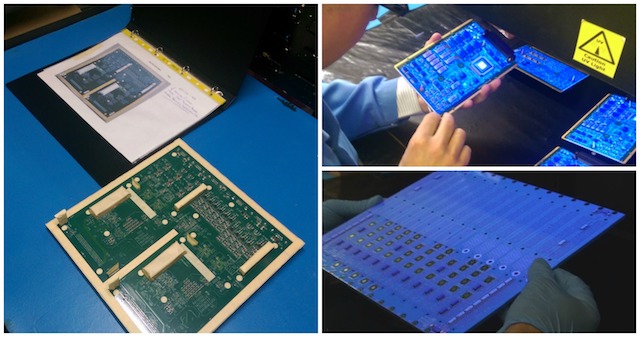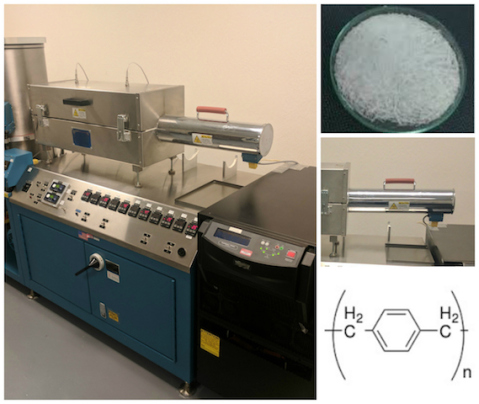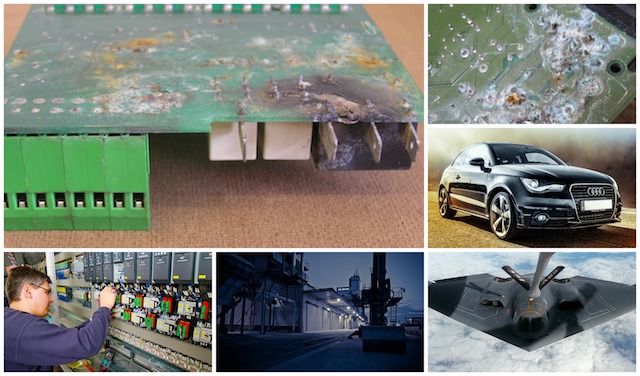The conformal coating production line, whether it is an operator manually brush coating printed circuit boards (PCBs) or an inline robotic spray coating process is typically made up of several stages.
However, not all the stages are mandatory or may be required. These stages are shown below:

Consider each stage below.
Boards In / Boards Out
This is very straightforward. The PCBs are delivered to the conformal coating area ready for processing.
Inspection

Inspecting the circuit boards before starting the conformal coating application process starts helps avoid stopping the line if there is a problem.
The initial inspection process can also identify which PCBs are to be coated, the material to be used and how they are to be coated.
This can be done automatically as part of the production process or completed by the operator.
Cleaning
Cleaning the circuit boards before application of conformal coating may or may not be required.
This is a decision that should be made earlier on in the design stage before production actually starts.
However, if you do decide to clean then consider these guidelines:
- Ensure that the cleaning process does not add more contaminants to the PCB than it started with due to entrapment of cleaning fluids.
- Make sure the PCBs are dry enough for the conformal coating process and the cleaning process not leave water entrapped under components that could impede the application.
- Ensure the cleaning process actually removes residues that may cause defects like de-wetting to minimise finishing at the end of the process.
Again, cleaning is for the engineers to decide. The option of whether you need to clean your circuit boards for conformal coating is a whole topic on its own.
Masking

Masking may not be required on the circuit board. However, generally there are very few circuit board assemblies that can be completely coated and have no areas that must not be conformal coated.
Some components on PCBs generally need to avoid having conformal coating applied to them.
This leaves three options:
- You can avoid coating the component or area using a selective application process.
- You can apply some form of masking that the conformal coating can be applied to and remove the masking materials after application.
- You can apply a conformal coating that does not need masking against.
Again, engineers need to consider their options on whether to use conformal coating masking as soon as possible.
Pre-Coating Inspection
Generally, it is more efficient to double check the masking process is correct before conformal coating application rather than repair the PCB after the process goes wrong because the masking process was incorrect.
This check can be manual or automated but it is highly valuable.
Coating Application

The one stage that cannot be avoided is the conformal coating applied to the PCB.
There are many different methods for applying conformal coatings and probably the most important factor in all of them is training. The operator needs to understand the process to be able to work correctly.
Drying and Curing
A conformal coating is a wet process (unless you use Parylene) and therefore the coating has to dry.
The difference between drying and curing in conformal coating is very different. However the process required depends on the conformal coating itself.
Care needs to be taken in deciding how to achieve the right result.
De-masking

Like masking, there is skill in removing the masking materials from the circuit board and not damaging the coating.
This is also where touch up (finishing) is carried out to ensure the final finished PCB is fit to pass the inspection criteria.
Work instructions are needed along with training on the specific methods of finishing to ensure this can be achieved.
Again, the work environment can be critical to achieve the right results.
Inspection
When the PCB is conformal coated and finished, you need to know if the product meets the inspection criteria.
The conformal coating inspection process can be done manually or automatically. This can depend on the volume of PCBs and the level of sophistication required.
Again, it is down to operator training and using the right equipment to ensure that this is possible.
Also, at this stage it is possible to measure process factors like coating conformal thickness to check that the criteria are met.
Other factors to consider
The set up of a conformal coating production line regardless of the application method has many similar characteristics.
General requirements
Any coating facility will need the basic requirements put in place that would be standard for any piece of electronic manufacturing process. These include ESD systems, facilities for the machines, the environmental requirements and the normal Health & Safety (HSE) considerations.
Health & Safety (HSE)
HSE tends to be more important for conformal coatings since in general the coatings themselves are hazardous, or the way they are applied makes them potentially harmful to operators
Environment
Conformal coatings are sensitive to the environment that they are processed. Cleanliness could be critical, as can temperature and humidity.
Summary
Setting up a conformal coating production facility can be a straightforward process as long as all factors are considered.
Get this right and many of the problems that could occur during production will be avoided.
Need to find out more?
Click conformal coating production processes for further information or contact us directly and we can help you.
If you are new to Nexus and our work on conformal coatings then a good place to go is our Start Here page or our free conformal coating eBook.r










 Polyurethane conformal coatings are used in nearly all sectors where electronic circuit boards are used including:
Polyurethane conformal coatings are used in nearly all sectors where electronic circuit boards are used including: Parylene is a conformal coating that can be applied to electronic circuit board assemblies that is deposited as a gas in a vacuum chamber.
Parylene is a conformal coating that can be applied to electronic circuit board assemblies that is deposited as a gas in a vacuum chamber.
